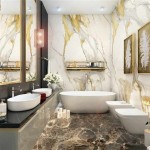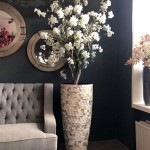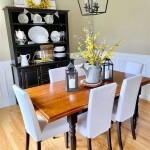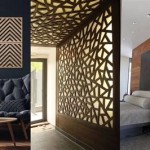Photo Wall Decor Ideas: Transforming Spaces with Personal Memories
Photo walls represent a powerful and versatile method for personalizing interior spaces. They offer a way to curate and display cherished memories, creating a visual narrative that adds character and warmth to a home or office. Far beyond simple decoration, a well-designed photo wall can become a focal point, sparking conversation and evoking positive emotions for both residents and visitors.
The appeal of photo walls lies in their inherent flexibility. They can be adapted to accommodate various styles, sizes, and budgets. From minimalist arrangements using identical frames to eclectic galleries showcasing a diverse range of images and textures, the possibilities are virtually limitless. The key to a successful photo wall is careful planning and execution, taking into account the existing decor, available space, and desired aesthetic.
Selecting the Right Photographs
The foundation of any compelling photo wall rests on the selection of photographs. Consider the overall theme or message the wall is intended to convey. Is it a celebration of family milestones, a tribute to travel adventures, or a display of artistic expression? The chosen photographs should align with this central concept, creating a cohesive and visually appealing narrative.
Quality is paramount. While sentimental value is important, blurry or poorly composed images detract from the overall impact. Opt for high-resolution photographs that are well-lit and possess clear subject matter. Consider enhancing the images through editing software, adjusting brightness, contrast, and color balance as needed. Black and white conversions can add a touch of elegance and timelessness, especially when used consistently throughout the wall.
Variety in subject matter and composition is also crucial. Mixing portraits with landscapes, candid shots with posed photographs, and close-ups with wide angles creates visual interest and prevents the wall from appearing monotonous. Consider incorporating photographs taken at different times and locations to tell a more comprehensive story.
Beyond personal photographs, consider incorporating other types of imagery. Prints, illustrations, and even vintage postcards can add texture and depth to the display. These supplemental elements can complement the photographs and enhance the overall aesthetic appeal. The choice of imagery should reflect the homeowner's personality and style, creating a truly unique and personalized space.
Frame and Layout Considerations
The framing and layout of a photo wall are equally important as the photographs themselves. The choice of frames can significantly impact the overall aesthetic, influencing the formality, style, and perceived value of the display. Consistency in frame style can create a cohesive and polished look, while incorporating a variety of frames can add a touch of eclecticism and personality.
Matching frames in terms of color and material is a common approach, especially for minimalist or contemporary designs. Black, white, and natural wood frames are versatile options that complement a wide range of photographs and decor styles. Metallic frames, such as gold or silver, can add a touch of elegance and sophistication, while brightly colored frames can inject a playful and energetic vibe.
The size and shape of the frames should also be considered. Using a mix of frame sizes can create visual interest and prevent the wall from appearing static. Consider incorporating larger statement frames alongside smaller, more delicate frames. The shape of the frames can also influence the overall aesthetic. Rectangular frames are a classic choice, while square frames can add a modern touch. Oval or circular frames can introduce a softer, more organic feel.
The layout of the photo wall is crucial for creating a visually appealing and balanced display. There are several common layout styles to choose from, each with its own unique characteristics. A symmetrical grid layout is a classic and formal option, ideal for displaying a collection of identically sized and framed photographs. An asymmetrical or gallery wall layout offers a more relaxed and eclectic feel, allowing for a greater degree of creativity and personalization. A linear or horizontal layout is well-suited for narrow hallways or above furniture pieces, creating a streamlined and cohesive display.
Before committing to a particular layout, it is helpful to create a mock-up of the photo wall. This can be done using paper cutouts, templates, or digital design tools. Experimenting with different layouts and arrangements allows for fine-tuning and ensures that the final result is visually pleasing and balanced. Consider the spacing between frames, the alignment of the images, and the overall flow of the display.
Installation Techniques and Materials
Proper installation is essential for ensuring the longevity and stability of a photo wall. Choose appropriate hanging hardware based on the weight and size of the frames and the type of wall surface. For drywall, use picture hooks, nails, or anchors that are designed to support the weight of the frames. For plaster walls, use specialized plaster hooks or screws and anchors.
Before hammering or drilling, use a level to ensure that the frames are hanging straight. A laser level can be particularly helpful for aligning multiple frames in a symmetrical grid layout. Consider using painter's tape to mark the placement of each frame, preventing mistakes and ensuring a clean and professional finish.
For heavier frames, consider using wire hanging systems. These systems consist of a rail that is mounted to the wall and wires that are suspended from the rail, allowing for adjustable frame placement. Wire hanging systems are particularly useful for galleries or displays that are frequently updated or rearranged.
Beyond traditional hanging methods, consider alternative installation techniques. Adhesive strips or putty can be used to hang lightweight frames without damaging the wall surface. This is a good option for renters or those who prefer a less permanent solution. Floating shelves can also be used to display photographs, adding a dimensional element to the display. Leaning photographs against the wall is another option, creating a casual and relaxed aesthetic.
Lighting can also play a crucial role in enhancing the visual impact of a photo wall. Consider installing track lighting or spotlights to illuminate the display, highlighting the photographs and creating a dramatic effect. Natural light can also be used to enhance the colors and details of the images. Avoid placing the photo wall in direct sunlight, as this can cause the photographs to fade over time.

21 Photo Wall Ideas For Living Room Hanging Inspiration

Wall Art Ideas The Home Depot

55 Designer Approved Wall Decor Ideas For 2025

Designer Tips For Wall Art Crate Barrel

15 Wall Decor Ideas For Living Room Decorpot

21 Photo Wall Ideas For Living Room Hanging Inspiration

23 Creative Diy Wall Decor Ideas

18 Inexpensive Diy Wall Decor Ideas Bless Er House

30 Stylish Bedroom Wall Decor Ideas And Tips

Living Room Gallery Wall Love Grows Wild
Related Posts







